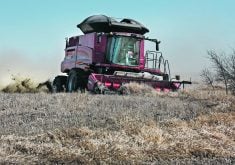Wet conditions this spring have forced many canola growers to broadcast seed by airplane or with a floater, mixing the seed in with granular fertilizer.
“These seeds are sprouting and growing in what is basically a hydroponic solution,” said Rob Park, crop specialist with Manitoba Agriculture.
“If you’re standing in the field, looking down at the seedlings, they appear to be healthy. It looks like you have good establishment. But when you get right down there to study what’s happening close up, it’s not such good news. The seeds have sprouted, but some roots went up instead of down.
Read Also

VIDEO: Ag in Motion documentary launches second season
The second season of the the Western Producer’s documentary series about Ag in Motion launched Oct. 8.
“When the sun comes out and we get some warm weather, that hydroponic solution on the soil surface will evaporate, leaving the seeds high and dry. The soil surface turns hard, so roots can’t penetrate, and your healthy looking seedling dies.”
Canola survival is bad at the best of times, Park said. Under perfect conditions, some seed lots might see survival approaching 75 percent in the field. When canola seed is broadcast, the survival rate varies, but it is always much lower than normal.
“Guys are broadcasting because they have no choice,” said Park. “Their backs are up against the wall. Everyone knows the odds are better if you can use your air seeder, but on many farms this year, there’s no choice.”
Half the seeds end up upside down when you broadcast, whether you use a floater or an airplane.
“When a round seed hits the ground, it bounces and rolls,” explained Park. “Then it lays there on the soil surface, in standing water or in mud. It’s just pure luck that determines which way the radicals emerge. They can be straight up towards the sky, straight off to the sides, straight down into the moist soil, or any angle in between.”
If the radical emerges skyward, it grows straight up for a while, then makes a 180 degree U-turn and tries to aim for the soil. If it emerges horizontally, it’s not quite as bad, but it still makes a 90 degree right angle turn to search for soil. In these situations, small seeds such as a canola expend most of their energy trying to reach soil.
If a normal survival rate with an air seeder is 50-60 percent, it’s likely that seed orientation can chop that number in half in a broadcast scenario.
“In order to qualify for crop insurance, you need four viable plants per foot square or 40 viable plants per metre square. It’s a gamble whether or not you get those counts unless you can somehow get in there with a harrows or some light cultivation tool to put some soil cover over those seeds.”
Many producers have been reluctant to put machinery into wet fields this year, for fear the wet conditions will cause soil compaction. As a result, fields that were broadcast seeded have not received the necessary harrow pass, other fields have gone unseeded and some spray applications have been cancelled.
However, contrary to what many people believe, waterlogged soils are not prone to compaction. Curtis Cavers, land management specialist with the ag department, said that compaction occurs when heavy implements force air out of the air pockets in the soil and push the soil particles closer together.
“Once you have the kind of saturated soils we’re seeing this year, those pores and pockets are already full of water. You cannot compress them further simply because you cannot compress water as you can air. The water and mud just squish out of the way. It makes terrible ruts in the field, of course, but it does not cause compaction.”
Cavers said, “the other situation you want to be wary of is heavy soils that are saturated at the surface but drier down below. You can really pack those soils badly if you aren’t careful.
“If you’re not sure, the best thing is call your local extension soils specialist or the agronomist you work with at your supplier. A lot of times they may have a penetrometer, which can give you a good idea whether or not there is a compaction problem.”
Cavers said a basic penetrometer sells for about $200.
“A cheaper alternative is to just take your spade and dig a hole. If there’s a compacted layer down there, you’ll find it.”
With saturated soil situations, there will be a range of plant maturity groups, making it difficult for the grower to decide the timing of herbicides, fungicides, insecticides, swathing and combining. Park said a grower has no choice but to pick a favourite group of seedlings and abandon the rest.
“You have to be ruthless in making the decision. We all know that you cannot manage a field for the whole range of maturity groups. Study the field, pick a growth stage that seems to have the most viable plants and decide that this one is your canola crop for this year. Concentrate all your inputs on that one maturity group.
“You can’t wait for the stragglers, because they’ll never catch up. You can’t put too much emphasis on the leaders, because even though they may look good, the numbers might not be there. They’ll be over-staged.”
He said canola is resilient and can compensate for problems. It fills in where needed and often pulls through in July and August, even when experts have written it off.
“It’s a long summer yet and a lot will depend on the heat we get in July and August and when the first frost arrives in September. There’s still an opportunity for some of those canola fields to produce very well.”
Leaving a waterlogged field fallow is one of the worst things to do because it promotes water accumulation instead of water consumption. Planting canola on that field could be a smart move.
“Your aim right now is to figure out how to put crop on those fields to consume five or hopefully even 10 inches of water. We’re not in the water conservation business on the Prairies this year. We want high water usage plants on these saturated fields,” said Cavers.
Late seeded crops of any kind are always less efficient when it comes to water use. That means they suck up a lot of water for the amount of product they will yield.
“Basically, anything you plant now will help. Canola is always a big water user in late seeding situations, so that’s a good choice. Other crops that suck up water for you are millet and cereals grown for green manure. Or, if there’s volunteer canola in a waterlogged field, consider leaving it alone until fall.
“Even if you’re up to mid-July, try to get a crop on those fields. The seedlings react to the late seeding date and drink up lots of water trying to play catch-up. You’re not going to get a decent yield, but that’s not the point. If you don’t use up that excess moisture this summer, it’ll be there waiting for you in 2006.”
If a summer-seeded crop is out of the question, another option is to concentrate on getting those fields ready for winter wheat in mid-August.
Some producers may want to leave their weeds to drink up the excess water. While this option may be forced on some farmers, Cavers said there’s always the obvious risk that the situation can get out of hand. If the chemical application can’t be made before those weeds go to seed, the results could be disastrous.
“Expect to see a lot of weeds with the words ‘marsh’ or ‘swamp’ in their name,” said provincial weed specialist Bruce Murray. “These are weeds that have been locked in the seed bank in the soil, perhaps for many decades.”
Some of the aquatic weeds appearing in fields are curl dock, marsh yellow cress, swamp smartweed, scouring rush or horsetail, and even bulrush and cattail.
“Wherever there’s a hole, Mother Nature is quick to fill it with the appropriate plant or animal. So, it’s a different mix of weeds than what we’re used to.”
Murray said with wet conditions prevalent in all regions, the canola crop is generally in poor condition, while most of the weed species are doing well. Even with a good chemical or mechanical weed control program, farmers still rely on competition from the crop to help control weeds. That competition is not present this year.
In those fields where spraying will be possible, it may be necessary to spray different areas at different times because of the growth stages of both weeds and crops.
Nitrogen loss is another reason for a proactive approach to saturated soil. Denitrification can eat up to four pounds per acre of nitrogen each day through the saturation period.
“If the soil is saturated and the temperature is 10 C or higher, you can expect that denitrification is happening,” said Cavers. “Given the warm weather recently, I’d say there’s no doubt it’s going on right now.
“If you’ve got a whack of nitrogen in the soil in the nitrate form, which is probably what it has converted to by now, there is an economic loss taking place. Fertilizer inputs are being lost.
“The microbes in the soil are looking for an oxygen source. The air pockets are all full of water now, so there’s no free oxygen available to them. Nitrate is NO3. That’s where the microbes are going now for their oxygen.”
Cavers urges producers to consider putting in crops that will help them recover some of that nitrogen fertilizer investment, either as greenfeed or some other type of salable crop, and use up water.















